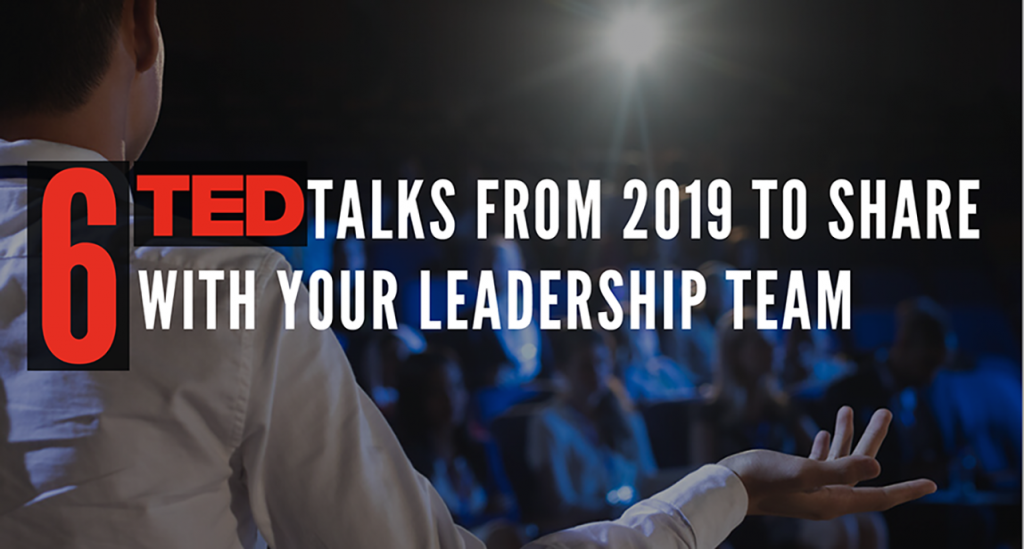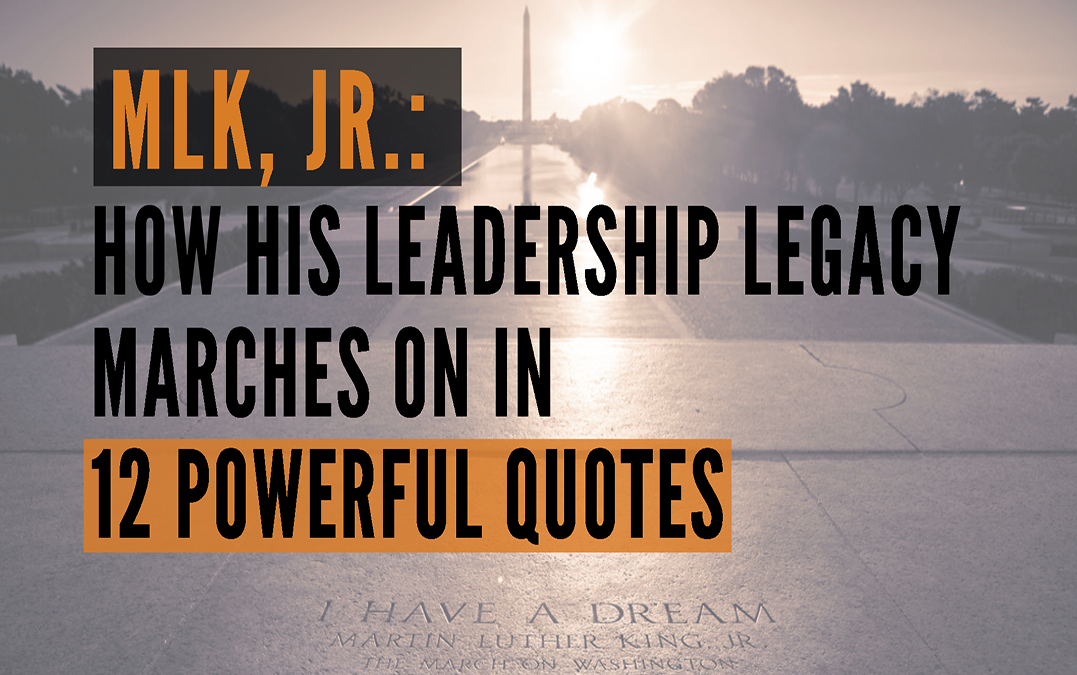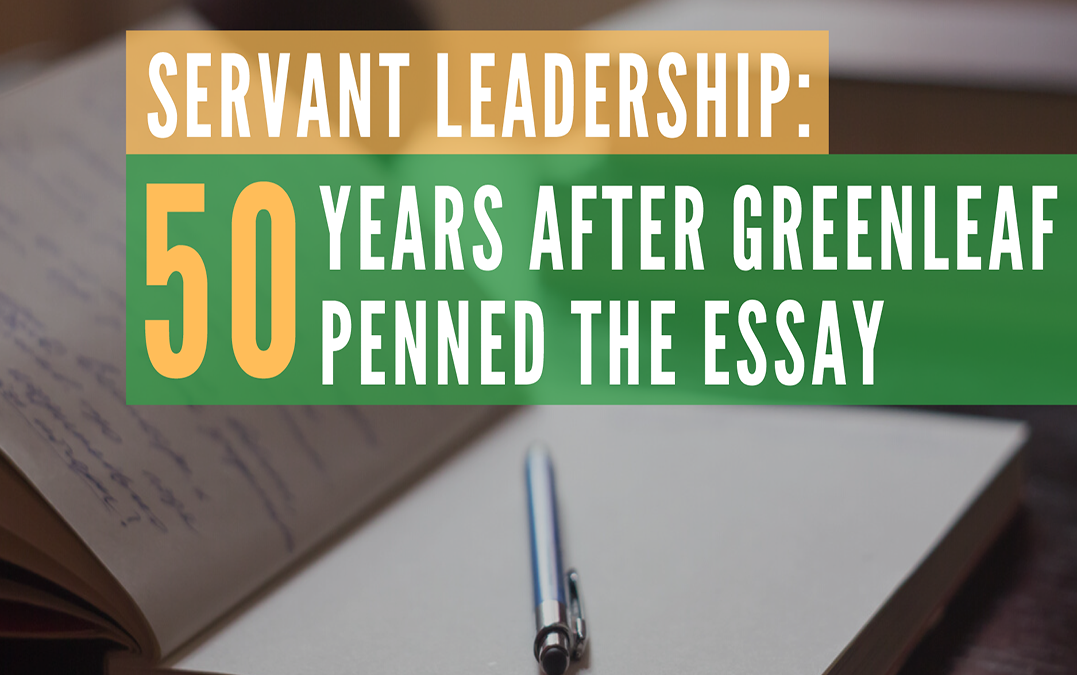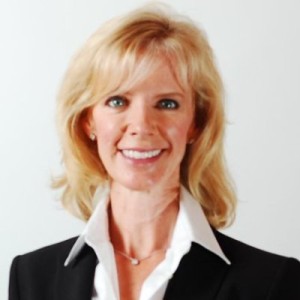
Leadership
It’s time to decide how you want to lead your organization in 2020. How did your leadership team impact organizational culture, and, ultimately, performance, in 2019? Were they too busy focusing on daily demands to read case studies and dig through reports about the latest leadership topics? Since 2006, TED Talks have provided accessible content on topics that stimulate new ideas about unexplored topics.
Here are six TED Talks from 2019 worth sharing and discussing with your leadership team this year.
1. How to break bad management habits before they reach the next generation of leaders by Elizabeth Lyle (Posted January 2019)

What it’s about and why watch it: Companies are counting on their future leaders to manage with more speed, flexibility and trust than ever before. But how can middle managers lead the organizations of tomorrow while also challenging the way things have always been done? Leadership expert Elizabeth Lyle offers a new approach to breaking the rules while you’re on your way up, sharing creative ways organizations can give middle managers the space and coaching they need to start leading differently.
2. What are you willing to give up to change the way we work? by Martin Danoesastro (Posted January 2019)
What it’s about and why watch it: What does it take to build the fast, flexible, creative teams needed to challenge entrenched work culture? For transformation expert Martin Danoesastro, it all starts with one question: “What are you willing to give up?” He shares lessons learned from companies on both sides of the innovation wave on how to structure your organization so that people at all levels are empowered to make decisions fast and respond to change.
3. The anti-CEO playbook by Hamdi Ulukaya (Posted May 2019)

What it’s about and why watch it: Profit, money, shareholders: these are the priorities of most companies today. But at what cost? In an appeal to corporate leaders worldwide, Chobani founder Hamdi Ulukaya calls for an end to the business playbook of the past — and shares his vision for a new, “anti-CEO playbook” that prioritizes people over profits. “This is the difference between profit and true wealth,” he says.
4. The human skills we need in an unpredictable world by Margaret Heffernan (Posted August 2019)

What it’s about and why watch it: The more we rely on technology to make us efficient, the fewer skills we have to confront the unexpected, says writer and entrepreneur Margaret Heffernan. She shares why we need less tech and more messy human skills — imagination, humility, bravery — to solve problems in business, government and life in an unpredictable age. “We are brave enough to invent things we’ve never seen before,” she says. “We can make any future we choose.”
5. What productive conflict can offer a workplace by Jess Kutch (Posted October 2019)

What it’s about and why watch it: Got an idea to make your workplace better? Labor organizer and TED Fellow Jess Kutch can show you how to put it into action. In this quick talk, she explains how “productive conflict” — when people organize to challenge and change their work lives for the better — can be beneficial for employees and employers alike.
6. The business case for working with your toughest critics by Bob Langert (Posted November 2019)

What it’s about and why watch it: As a “corporate suit” (his words) and former VP of sustainability at McDonald’s, Bob Langert works with companies and their strongest critics to find solutions that are good for both business and society. In this actionable talk, he shares stories from the decades-long transition into corporate sustainability at McDonald’s — including his work with unlikely partners like the Environmental Defense Fund and Temple Grandin — and shows why your adversaries can sometimes be your best allies.
Bottom line. To lead effectively today, you need to constantly test your assumptions and recalibrate outdated thinking. Help your leadership team challenge its perception by building a library of resources that challenge perceptions and build new leadership models for the 21st century.
Question: What resources do you use to stimulate new ideas with your leadership team?
Driven by the premise that excellence is the result of aligning people, purpose and performance, Center for Executive Excellence facilitates training in leading self, leading teams and leading organizations. To learn more, subscribe to receive CEE News!

Leadership
Last week, Martin Luther King, Jr. would have turned 91. While it is customary to look to our elders for sage advice, King knew that he was walking a path of imminent danger, but that his words could not be silenced by a bullet. Before his assassination at age 39, King reached deep within himself to find messages that would ring as clear and true today as they did during the turbulent times in which he was called to lead.
Here are 12 quotes from 1960 (at age 31) to 1969 (the night before he was killed eight years later) that are part of Dr. King’s enduring legacy.
1. In the final analysis, the question will be, “What did you do for others?” (Three Dimensions of a Complete Life, Sermon delivered in Pasadena, CA, February 28, 1960.)
2. I am convinced that men hate each other because they fear each other. They fear each other because they don’t know each other, and they don’t know each other because they don’t communicate with each other, and they don’t communicate with each other because they are separated from each other. (Lecture given at Cornell College, Mount Vernon, Iowa, October 15, 1962.)
3. History has proven that social systems have a great last-minute breathing power, and the guardians of the status quo are always on hand with their oxygen tents to keep the old order alive. (Ibid.)
4. We often end up with the high blood pressure of creeds and an anemia of deeds. (Ibid.)
5. There comes a time when the cup of endurance runs over and men are no longer willing to be plunged into an abyss of injustice where they experience the bleakness of corroding despair. (Letter from a Birmingham Jail, written while in solitary confinement after being arrested on charges of violating Alabama’s law against mass public demonstrations, April 16, 1963.)
6. Even though we face the difficulties of today and tomorrow, I still have a dream. It is a dream deeply rooted in the American dream. (I Have A Dream, Address given at the March on Washington, August 28, 1963.)
7. I refuse to accept despair as the final response to the ambiguities of history. (Nobel Peace Prize Acceptance Speech in Oslo, Norway, December 11, 1964.)
8. We must learn to live together as brothers — or perish together as fools. (Remaining Awake Through a Great Revolution, Commencement Address for Oberlin College, June 1965.)
9. A genuine leader is not a searcher for consensus, but a molder of consensus. (Domestic Impact of the War, Speech before National Labor Leadership Assembly for Peace, November 1967.)
10. I have decided to stick to love…Hate is too great a burden to bear. (Where Do We Go From Here?, Address delivered at the 11th Annual SCLC Convention, August 1967.)
11. Everybody can be great because everybody can serve. (The Drum Major Instinct, Sermon given at Ebenezer Baptist Church, February 4, 1968, two months before his assassination.)
12. Either we go up together, or we go down together. (I’ve Been to the Mountaintop, Speech given at the Mason Temple, Memphis, TN, April 3, 1968, the night before his death.)
The last words of King’s speech at the Mason Temple were borrowed from The Battle Hymn of the Republic, “Mine eyes have seen the glory of the coming of the Lord.” At his funeral, his wife, Coretta, completed the stanza that King had been too overcome by emotion to add, “His truth is marching on.”
Question: Which of these quotes from Martin Luther King, Jr. do you find most compelling today?

Leadership
The year 2020 marks the 50th anniversary of the origins of servant leadership. Robert K. Greenleaf was a mid-20th century iconoclast who argued that leaders should use their positions of power to help their teams succeed rather than for self-interest and personal glory. It’s a powerful concept that has been put to the test by many organizations, including Southwest Airlines and WD-40.
Servant leadership still has a strong appeal for today’s leaders who have a bias for stewardship. Yet, many people who practice servant leadership in the 21st century are unclear about its origins. Whether you’ve never heard of the term servant leadership or consider yourself naturally drawn to this style of leadership, you may be interested in learning more about how Greenleaf came to develop the concept.
Midwestern values. Greenleaf was born in Terra Haute, Indiana, and bred with strong midwestern values. He was one of the first leadership theorists to introduce the concept of spirituality into management systems. Yet, Greenleaf did not refer to his experience with organized religion as important in shaping his ideas about leading organizations. In his essay, Seeker and Servant: Reflections On Religious Leadership, Greenleaf wrote, “I treasure the Judeo-Christian tradition. I do not value it above other traditions, but it is the one in which I grew up. The great symbolic wisdom of this tradition grows on me day by day. I regret the dogma that people have built around this tradition, which limits access to it. I cringe when I think of the wars that have been fought and may yet be fought because of the human tendency to forge hard doctrine out of the stories by which the wisdom of people and events, which make our tradition, have been handed to us…Much as I value the tradition in which I live, I feel compelled to leave it a mite better than I found it.”
Change from the inside. Greenleaf attended Carleton College in rural Minnesota in the mid-1920’s. One day, he was struck by a lecture given by his Economics professor, who said, “We are becoming a nation of large institutions – government, churches, businesses, universities – and none of these big institutions are serving well, either the people whom they are set up to serve or the people who staff them to render the service. They can only be changed from the inside, by somebody who knows how to do it and who wants to do it. Some of you students should make your way inside these institutions and become the ones who help them do better.”
Greenleaf took this lecture to heart. When he graduated, he took a job with American Telephone & Telegraph, then the largest company in the world. He worked his way up to eventually become in charge of management development. As he studied the company’s expansive business units over the next four decades, he found that the ones that performed the best over time had leaders who operated outside of the traditional command-and-control model. This experience gave Greenleaf both the quantitative and qualitative basis for establishing a business case for servant leadership.
Of E.B. White, Quakers, and LSD. Greenleaf was a brilliant thinker and researcher with a voracious appetite for soul searching. He gleaned insight from thought leaders, spiritual groups, and psychedelic drugs alike. In My Debt to E.B. White, Greenleaf concludes that White was gifted with, “seeing things whole” and “the language to express what he saw,” were key to his power as a writer. In the Quaker practice of consensus, Greenleaf found a way of making group decisions that honored all voices using silence, listening, and the role of the Chair – or Clerk – as a first among equals, no better or worse than anyone else. When experiments with mind-altering drugs were emerging in the late 1950’s, Greenleaf participated in several guided sessions that resulted in what he described as “permanent learning” of the heightened perception of color.
The orange booklet. In the late 1960’s, Greenleaf wrote an essay called The Servant as Leader. In the essay, he wrote, “The pyramid organizational structure with its dominating leader is no longer adequate . . . Followers choose leaders – authentic moral leaders– because they have proven their willingness to serve and even risk losing leadership by ‘venturing out for the common good.’” The servant leadership model reversed the polarity of power. In effect, it turned the pyramid upside down. It was an antidote to the command-and-control model that had served as the natural order of doing business for hundreds of years. The orange-covered essay began to circulate in the halls of some of Americas corporations, became the tinder for spreading the model of servant leadership in the U.S., and is still in publication today.
Robert K. Greenleaf died on September 29, 1980. The Philadelphia Inquirer wrote that he was, “a management consultant who preached that the human spirit is more important than the bottom line.” According to biographer Don Frick, Greenleaf summed up his life through the epitaph on his tombstone: “Potentially a good plumber ruined by a sophisticated education.”
Question: What do you know about the origins of servant leadership?

Letter from the Founder

Welcome to the fifty-third issue of CEE News!
Chances are, the turn of the decade has you thinking about how to be your best self this year. Doing so likely means taking stock of the rote habits in your life that are causing a drag on your energy. Simple enough in theory. Yet, simple is rarely simplistic.
The 19th century philosopher William James opined that all of our lives are but a mass of habits. Research published in a 2006 study found that about 40% of our daily action is habitual, which is still a good chunk of time spent in mindless behavior. And that was nearly 15 years ago. How much more distracted, distant and drained are we today by our digital lives and full-frontal political polarization? We can binge watch Netflix, try to beat the next level of Candy Crush, or take back our emotional and psychic space.
(more…)
![Sticky Solutions]()
Sticky Solutions
Sticky solutions to your everyday business challenges
 Question: Last year, I went home most days feeling like I was busy but that I hadn’t accomplished anything important. Even on days that I’d intentionally cleared my calendar to work on a big project, I would still get highjacked by Slack messages and “quick questions.” I don’t want to seem like I’m not a team player, but what can I do to stop feeling busy all the time without having anything to show for it?
Question: Last year, I went home most days feeling like I was busy but that I hadn’t accomplished anything important. Even on days that I’d intentionally cleared my calendar to work on a big project, I would still get highjacked by Slack messages and “quick questions.” I don’t want to seem like I’m not a team player, but what can I do to stop feeling busy all the time without having anything to show for it?
(more…)











